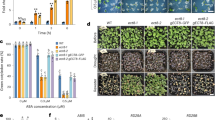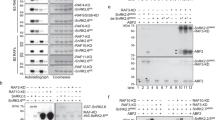Abstract
The phytohormone abscisic acid (ABA) mediates the adaptation of plants to environmental stresses such as drought and regulates developmental signals such as seed maturation. Within plants, the PYR/PYL/RCAR family of START proteins receives ABA to inhibit the phosphatase activity of the group-A protein phosphatases 2C (PP2Cs), which are major negative regulators in ABA signalling. Here we present the crystal structures of the ABA receptor PYL1 bound with (+)-ABA, and the complex formed by the further binding of (+)-ABA-bound PYL1 with the PP2C protein ABI1. PYL1 binds (+)-ABA using the START-protein-specific ligand-binding site, thereby forming a hydrophobic pocket on the surface of the closed lid. (+)-ABA-bound PYL1 tightly interacts with a PP2C domain of ABI1 by using the hydrophobic pocket to cover the active site of ABI1 like a plug. Our results reveal the structural basis of the mechanism of (+)-ABA-dependent inhibition of ABI1 by PYL1 in ABA signalling.
This is a preview of subscription content, access via your institution
Access options
Subscribe to this journal
Receive 51 print issues and online access
$199.00 per year
only $3.90 per issue
Buy this article
- Purchase on Springer Link
- Instant access to full article PDF
Prices may be subject to local taxes which are calculated during checkout






Similar content being viewed by others
References
Boudsocq, M., Barbier-Brygoo, H. & Laurière, C. Identification of nine sucrose nonfermenting 1-related protein kinases 2 activated by hyperosmotic and saline stresses in Arabidopsis thaliana . J. Biol. Chem. 279, 41758–41766 (2004)
Kobayashi, Y., Yamamoto, S., Minami, H., Kagaya, Y. & Hattori, T. Differential activation of the rice sucrose nonfermenting 1-related protein kinase 2 family by hyperosmotic stress and abscisic acid. Plant Cell 16, 1163–1177 (2004)
Mustilli, A., Merlot, S., Vavasseur, A., Fenzi, F. & Giraudat, J. Arabidopsis OST1 protein kinase mediates the regulation of stomatal aperture by abscisic acid and acts upstream of reactive oxygen species production. Plant Cell 14, 3089–3099 (2002)
Yoshida, R. et al. ABA-activated SnRK2 protein kinase is required for dehydration stress signaling in Arabidopsis . Plant Cell Physiol. 43, 1473–1483 (2002)
Fujii, H. & Zhu, J. Arabidopsis mutant deficient in 3 abscisic acid-activated protein kinases reveals critical roles in growth, reproduction, and stress. Proc. Natl Acad. Sci. USA 106, 8380–8385 (2009)
Nakashima, K. et al. Three Arabidopsis SnRK2 protein kinases, SRK2D/SnRK2.2, SRK2E/SnRK2.6/OST1 and SRK2I/SnRK2.3, involved in ABA signaling are essential for the control of seed development and dormancy. Plant Cell Physiol. 50, 1345–1363 (2009)
Furihata, T. et al. Abscisic acid-dependent multisite phosphorylation regulates the activity of a transcription activator AREB1. Proc. Natl Acad. Sci. USA 103, 1988–1993 (2006)
Fujii, H., Verslues, P. & Zhu, J. Identification of two protein kinases required for abscisic acid regulation of seed germination, root growth, and gene expression in Arabidopsis . Plant Cell 19, 485–494 (2007)
Hirayama, T. & Shinozaki, K. Perception and transduction of abscisic acid signals: keys to the function of the versatile plant hormone ABA. Trends Plant Sci. 12, 343–351 (2007)
Park, S. et al. Abscisic acid inhibits type 2C protein phosphatases via the PYR/PYL family of START proteins. Science 324, 1068–1071 (2009)
Pennisi, E. Plant biology. Stressed out over a stress hormone. Science 324, 1012–1013 (2009)
Ma, Y. et al. Regulators of PP2C phosphatase activity function as abscisic acid sensors. Science 324, 1064–1068 (2009)
Lee, B. & Richards, F. The interpretation of protein structures: estimation of static accessibility. J. Mol. Biol. 55, 379–400 (1971)
Tanokura, M. & Yamada, K. Heat capacity and entropy changes of calmodulin induced by calcium binding. J. Biochem. 95, 643–649 (1984)
Tanokura, M. & Yamada, K. A calorimetric study of Ca2+ binding by wheat germ calmodulin. Regulatory steps driven by entropy. J. Biol. Chem. 268, 7090–7092 (1993)
Das, A., Helps, N., Cohen, P. & Barford, D. Crystal structure of the protein serine/threonine phosphatase 2C at 2.0 Å resolution. EMBO J. 15, 6798–6809 (1996)
Meyer, K., Leube, M. & Grill, E. A protein phosphatase 2C involved in ABA signal transduction in Arabidopsis thaliana . Science 264, 1452–1455 (1994)
Leung, J. et al. Arabidopsis ABA response gene ABI1: features of a calcium-modulated protein phosphatase. Science 264, 1448–1452 (1994)
Koornneef, M., Reuling, G. & Karssen, C. The isolation and characterization of abscisic acid-insensitive mutants of Arabidopsis thaliana . Physiol. Plant. 61, 377–383 (1984)
Kabsch, W. Automatic processing of rotation diffraction data from crystals of initially unknown symmetry and cell constants. J. Appl. Crystallogr. 26, 795–800 (1993)
Matthews, B. W. Solvent content of protein crystals. J. Mol. Biol. 33, 491–497 (1968)
Schneider, T. & Sheldrick, G. Substructure solution with SHELXD. Acta Crystallogr. D 58, 1772–1779 (2002)
Bricogne, G., Vonrhein, C., Flensburg, C., Schiltz, M. & Paciorek, W. Generation, representation and flow of phase information in structure determination: recent developments in and around SHARP 2.0. Acta Crystallogr. D 59, 2023–2030 (2003)
Terwilliger, T. Automated main-chain model building by template matching and iterative fragment extension. Acta Crystallogr. D 59, 38–44 (2003)
Murshudov, G. N., Vagin, A. A. & Dodson, E. J. Refinement of macromolecular structures by the maximum-likelihood method. Acta Crystallogr. D 53, 240–255 (1997)
McRee, D. E. XtalView/Xfit–A versatile program for manipulating atomic coordinates and electron density. J. Struct. Biol. 125, 156–165 (1999)
Lovell, S. C. et al. Structure validation by Cα geometry: φ,ψ and Cβ deviation. Proteins 50, 437–450 (2003)
Delaglio, F. et al. NMRPipe: a multidimensional spectral processing system based on UNIX pipes. J. Biomol. NMR 6, 277–293 (1995)
Johnson, B. Using NMRView to visualize and analyze the NMR spectra of macromolecules. Methods Mol. Biol. 278, 313–352 (2004)
Acknowledgements
The synchrotron-radiation experiments were performed at BL5A in the Photon Factory (2008S2-001). This work was supported by the Targeted Proteins Research Program (TPRP) of the Ministry of Education, Culture, Sports, Science, and Technology, Japan. We thank Y. Sakaguchi (DKSH Japan K.K.) and Y. Asami (TA Instruments Japan Inc.) for the ITC measurements and T. Mitani (GE Healthcare Japan Corp.) for the SPR experiments.
Author Contributions M. Tanokura conceived and designed the project. K.-i.M., T.M., Y.S. and K. Kubota performed the construct design, subcloning, protein expression, purification, crystallization, structure determination and all biochemical assays. H.-J.K., A.A., Y.M, M. Takahashi and Y.Z. also assisted in the subcloning, protein expression, purification and crystallization. Y.F., T.Y. and K. Kodaira performed the cloning. K.-i.M., T.M., Y.S, K. Kubota, K.Y.-S. and M. Tanokura wrote the manuscript and M. Tanokura edited the manuscript.
Author information
Authors and Affiliations
Corresponding author
Supplementary information
Supplementary Information
This file contains Supplementary Results and Discussion, Supplementary References, Supplementary Tables 1 - 2 and Supplementary Figures 1 - 8 with Legends. This file was replaced on 24 December 2009 to correct minor errors in Supplementary Table 1. (PDF 4241 kb)
Rights and permissions
About this article
Cite this article
Miyazono, Ki., Miyakawa, T., Sawano, Y. et al. Structural basis of abscisic acid signalling . Nature 462, 609–614 (2009). https://doi.org/10.1038/nature08583
Received:
Accepted:
Published:
Issue Date:
DOI: https://doi.org/10.1038/nature08583
This article is cited by
-
Orthogonal inducible control of Cas13 circuits enables programmable RNA regulation in mammalian cells
Nature Communications (2024)
-
An orthogonalized PYR1-based CID module with reprogrammable ligand-binding specificity
Nature Chemical Biology (2024)
-
The CBL1/9-CIPK1 calcium sensor negatively regulates drought stress by phosphorylating the PYLs ABA receptor
Nature Communications (2023)
-
A Medicago truncatula lncRNA MtCIR1 negatively regulates response to salt stress
Planta (2023)
-
Genome-wide identification and expression analysis of SnRK2 gene family in common bean (Phaseolus vulgaris L.) in response to abiotic stress
Biologia (2023)
Comments
By submitting a comment you agree to abide by our Terms and Community Guidelines. If you find something abusive or that does not comply with our terms or guidelines please flag it as inappropriate.



